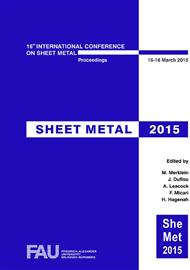p.179
p.187
p.195
p.205
p.213
p.221
p.227
p.235
p.243
Numerical Analysis and Experimental Validation of the Thermo-Mechanical Flow Behaviour of the Hot Stamping Steel MBW® 1500
Abstract:
In virtual design of the hot stamping process, a reliable description of the material flow behaviour is an important input to ensure accurate estimations of the parts feasibility. Currently, to characterise the hot stamping material’s flow behaviour at elevated temperatures, tensile and upsetting tests are available. The measurement of the flow behaviour out of such tests, which is generally temperature and strain rate dependent, still remains a complex task. Therefore traditional methods to measure flow curves out of such measurements are not necessarily precise enough. In this contribution the authors focus on non-isothermal conductive tensile tests of the manganese-boron steel MBW® 1500 in order to understand its flow behaviour at elevated temperature. Numerical calculations using Finite Element Method (FEM) of the tests itself with correct boundary conditions as well as for all necessary phenomena are used to identify accurately the material’s flow curves by use of inverse optimisation. Finally, for validation purpose the identified flow curves out of the optimisation method were used to simulate the hot stamping of two different parts. Both geometries were chosen such that various strain paths are covered i.e. uniaxial tension to plane strain.
Info:
Periodical:
Pages:
213-220
Citation:
Online since:
March 2015
Authors:
Keywords:
Price:
Сopyright:
© 2015 Trans Tech Publications Ltd. All Rights Reserved
Share:
Citation:


